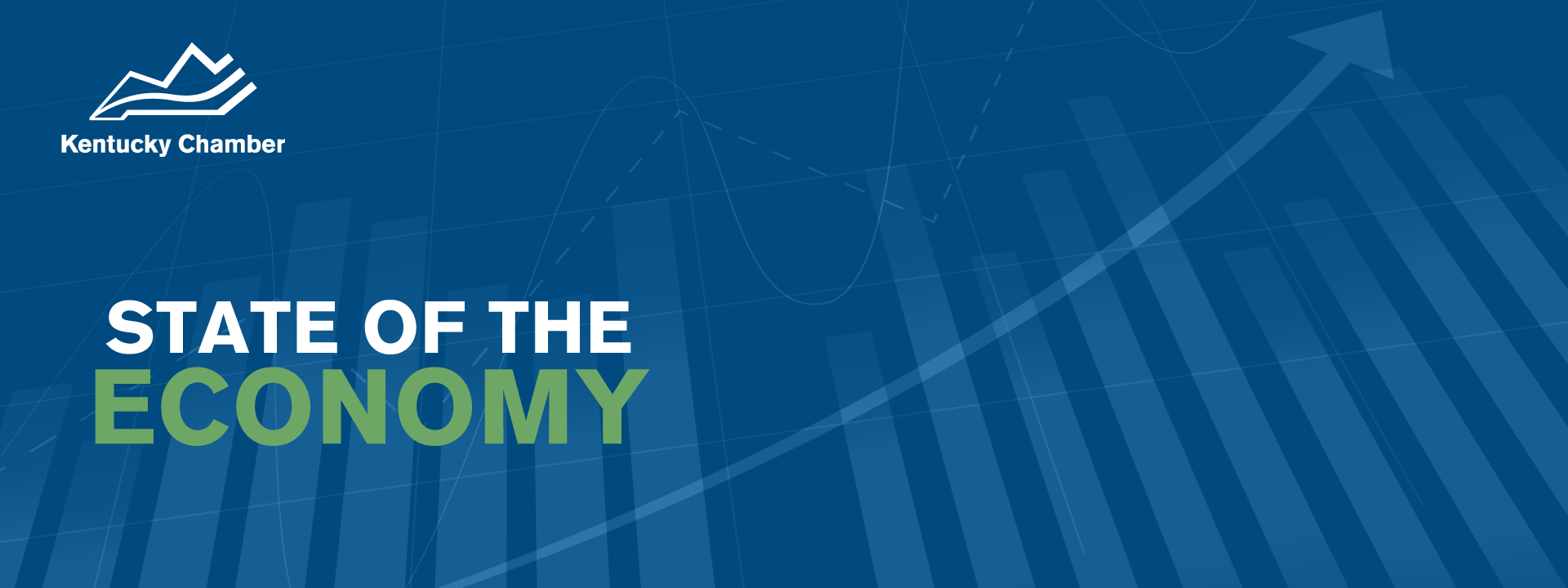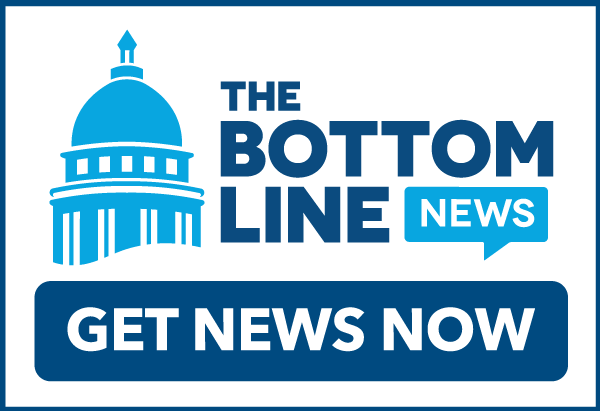Five Things to Know About The Economy
The government shutdown continues to affect the availability and quality of key economic indicators. Some labor market statistics have improved in Kentucky compared to the United States. However, there are signs of “cooling” in the labor market for both Kentucky and the U.S., especially when it comes to hiring. Inflation in the U.S. remains higher than what the Federal Reserve has been targeting. Consumer sentiment reached an all-time low in November 2025 and remains far lower than this time last year.
Here are five things to know about the economy as of December 22, 2025.
Unemployment
Unemployment has been rising in the U.S. but falling in Kentucky.
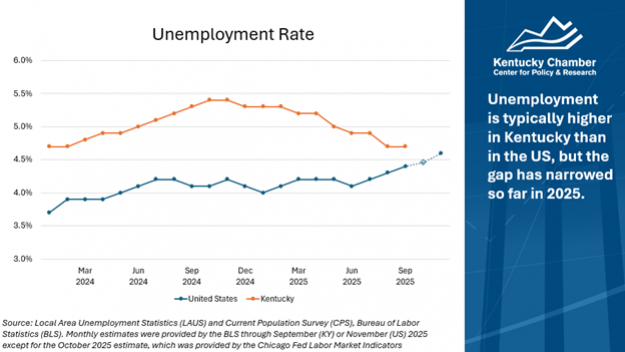
- Unemployment is defined as not being employed and actively searching for a job. People who don’t have jobs and are not actively searching are counted as being out of the labor force.
- The unemployment rate can fall or rise as people have an easier or harder time finding a job, but it can also fall if people without jobs leave the labor force or rise if more people enter the labor force. This is why we should also look at other metrics to understand changes in the unemployment rate.
- Because of the government shutdown, we will never have government labor market statistics for October 2025. Moreover, the government shutdown necessitated methodological changes, which are believed to have affected readings for November 2025.
Hiring Vs. Separations
Hiring seems to be weakening, but layoffs are mostly stable.
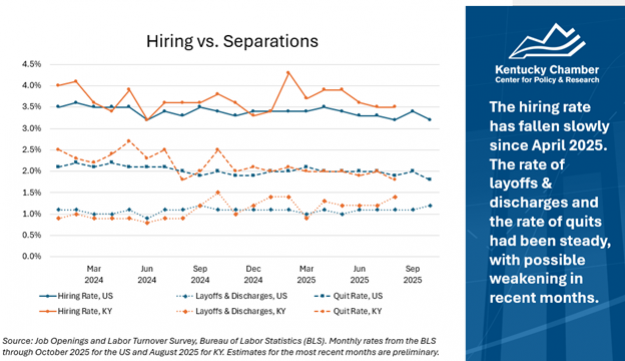
- Slowing hiring in the U.S. likely explains at least some of the increase in the national unemployment rate.
- The hiring rate being higher in Kentucky than the U.S. from February to July 2025 is consistent with the relative improvements in other labor market metrics for the Commonwealth. But, overall, this evidence is consistent with a slow cooling of the labor market in both Kentucky and the U.S. Hiring has deteriorated slowly.
- Businesses appear less willing to hire, but the relatively stable rates of layoffs and discharges suggest they are also reluctant to make any major changes.
- Media stories of mass layoff announcements usually provoke more concern than is warranted. Economic data suggest there are around 1.7 million layoffs and discharges every month in the U.S. That said, recent preliminary estimates show a small increase in layoffs.
- Quits have been low, suggesting workers aren’t finding (or expecting to find) better jobs than what they have.
- A “slow hire/slow fire” labor market tends to negatively impact younger workers, which is reflected in the unemployment data.
Job Growth
U.S. job growth has slowed, while growth in Kentucky has been more positive.
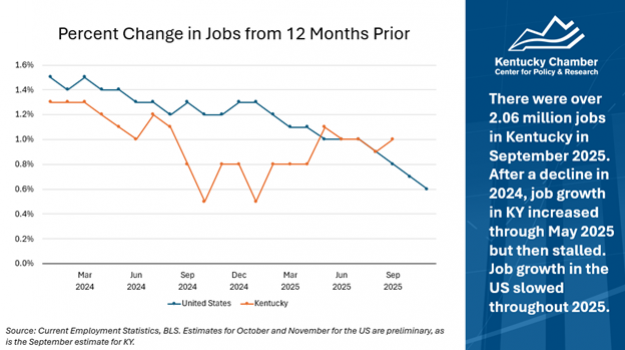
- Measuring the 12-month change in jobs as a percentage allows for more direct comparisons of Kentucky and U.S. job growth and naturally removes the seasonality of month-to-month changes.
- The positive changes in job growth seen in Kentucky in early 2025 and the slowing growth in the U.S. are consistent with the narrowing gap in unemployment and other labor market statistics.'
- The number of jobs is not the same as the number of employed people. Some people hold multiple jobs, and some jobs are held by residents of other states.
- The August and September estimates for the U.S., as well as the August estimate for Kentucky, were revised downward slightly in the December new release by the Bureau of Labor Statistics.
Inflation
Inflation remains higher than what federal policymakers are targeting.
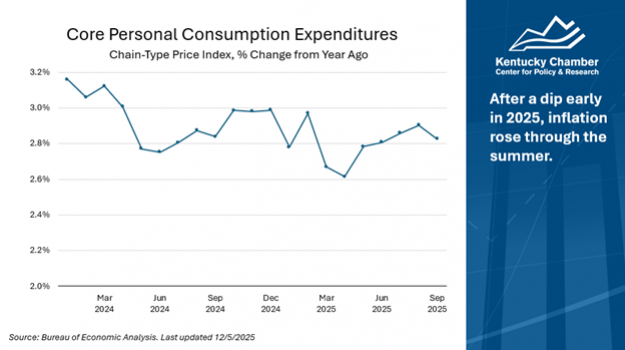
- Core Personal Consumption Expenditures (PCE) – which excludes food and energy – is the Federal Reserve’s preferred inflation metric.
- The Fed targets 2% inflation using Core PCE, which the U.S. has not seen since 2021.
- The increase in inflation shown since April 2025 is consistent with the effects of tariffs; however, those effects were very likely blunted by the anticipatory increase in imports earlier in the year.
- Firms appear reluctant to raise prices until they run through the inventories they accumulated earlier. It is possible that many are hoping they can wait out the worst of the tariffs and import more after deals are struck or the Supreme Court rules.
- The government shutdown has impacted the quality of some inflation data and delayed the release of other data. Data collection will hopefully normalize in 2026, giving us a clearer picture of inflation.
Consumer Sentiment
Inflation has shown signs of acceleration recently.
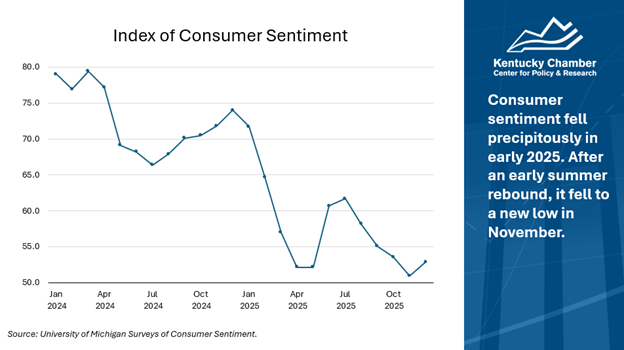
- The University of Michigan produces an index of consumer sentiment and updates it monthly.
- The November 2025 reading of 51.0 was an all-time low on the index.
- The December 2025 reading of 52.9 is within the index’s margin of error and represents a decrease of 28.5% relative to December 2024.
- Looking at components of the index, respondents’ assessment of Current Economic Conditions fell slightly between November and December, but the Index of Consumer Expectations rose slightly.
About This Data
On this web page, we provide economic updates on Kentucky and the United States, using a range of key metrics from the U.S. Department of Labor, U.S. Bureau of Economic Analysis, the University of Michigan, the St. Louis Federal Reserve, and the U.S. Chamber of Commerce. All data is analyzed by the Kentucky Chamber Center for Policy and Research. On this page, we cover jobs, unemployment, unemployment insurance claims, hiring, workforce participation, inflation, consumer sentiment, and small business optimism.
Sources
Federal Reserve Bank of St. Louis, Federal Reserve Economic Data
MetLife and U.S. Chamber of Commerce, Small Business Index
University of Michigan, Survey Research Center, Surveys of Consumers
U.S. Bureau of Economic Analysis, Personal Consumption Expenditures Price Index
U.S. Bureau of Labor Statistics, Local Area Unemployment Statistics
U.S. Bureau of Labor Statistics, Labor Force Statistics from the Current Population Survey
U.S. Department of Labor, Employment and Training Administration, Unemployment Insurance Data
U.S. Federal Reserve, Economy at a Glance – Inflation (PCE)
ADP Employment Report
Carlyle
Revelio Labs
U.S. Tariffs on Track to Hit 84-Year High Under Current Proposals, Tax Foundation Says
The Kentucky Chamber hosted a webinar on June 9, 2025, featuring Vice President of Policy Charles Aull and Erica York, Vice President of Federal Tax Policy at the Tax Foundation, to explore how tariff and tax policies in Washington are shaping the economic landscape for Kentucky businesses.
Watch the webinar below:
